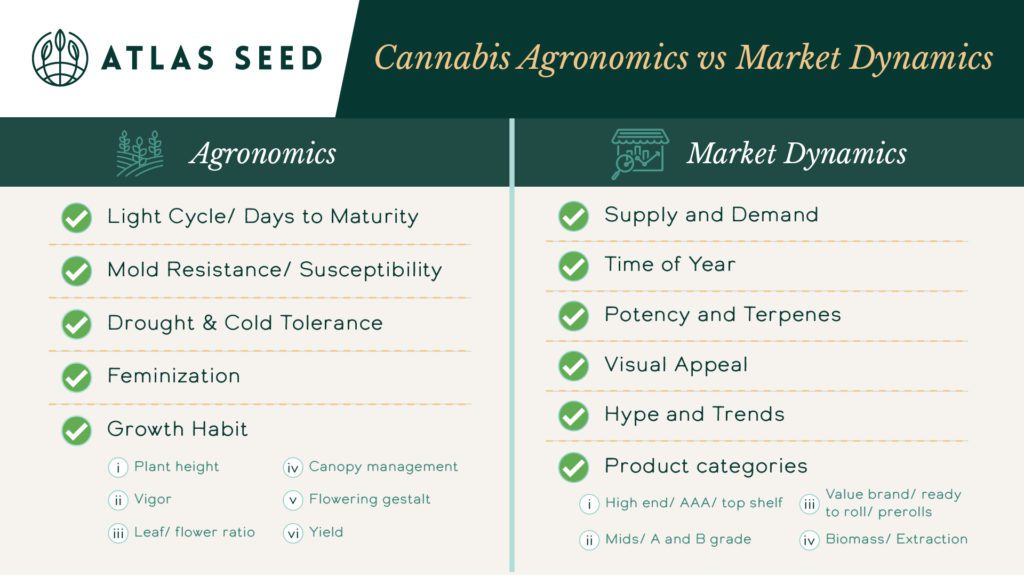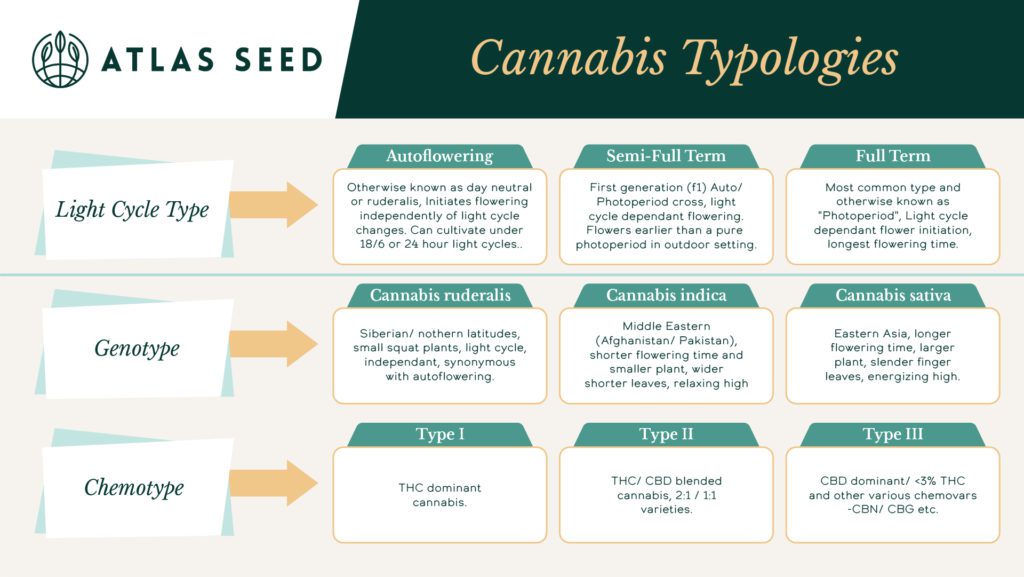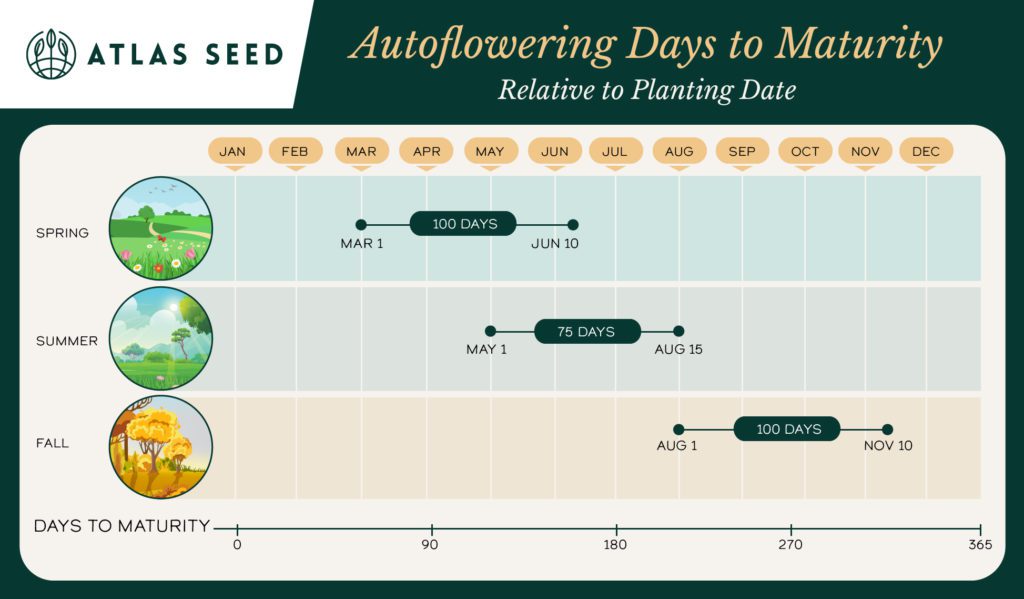Understanding How Cannabis Initiates its Flowering Phase
The Differences Between the Classifications Full Term, Semi-Full Term, and Autoflowering.
Cannabis genetics fall into two categories: short day (Cannabis sativa/indica) and day neutral (Cannabis ruderalis x sativa/indica). In the industry, people refer to short-day varieties as full-term or photoperiod determinant, and they commonly call day-neutral varieties autoflowers. Based on the cannabis light cycle, a a plant that requires a long period of darkness is termed a “short day” (long night) plant. Short-day plants form flowers only when day length is decreasing, and for cannabis, is less than 14 hours.
Many fall flowering plants are short day plants. Short-day cannabis falls into two categories: full term and semi-full term. Full term varieties finish later in the season, in October and sometimes into November. Semi-full term varieties, which are the first generation cross between a full term and autoflower, in general finish mid to late September to early October. They will initiate earlier in the season as well as finish their flowering cycle faster than their full term counterparts. In our side by side experience, full term genetics initiate flowering in the first week of August roughly, and semi-full term genetics in July. It is important to note that this is not a rubric, as seeding and planting dates have as much to do with this example as time of year.
Day-Neutral Cannabis: Autoflowers
Day neutral cannabis, or autoflower, is Cannabis ruderalis, which is a Siberian subspecies that evolved to flower in the far north where the summer day length is over 20 hours. It will initiate flowering regardless of day length. Ruderalis has been crossed and back crossed and crossed again with indica and sativa to create the varieties available today. Day-neutral plants typically do not reach more than 4’ in height and their days to maturity normally do not exceed 90 days. There are some exceptions to this including a subset of autoflowers people call “super autos” that can go 100 days plus in the main season; but for the purposes of this article they are less common and still initiate their flowering on a timer rather than a light change trigger.
Though auto’s most commonly take 70-80 days to reach full maturity, it’s important to understand that this time period is stretched in the shoulder seasons due to the availability of light and heat for completing their normal growth processes. In this way auto’s are like any other normal agricultural plant in that they are still reliant on light to pace and complete their metabolic development. They just don’t rely on light differences to initiate flowering as with full term and semi-full term varieties. See the Autoflowering Days to Maturity graphic at the bottom of this page to understand this a little more clearly.
Benefits of Autoflowers for Efficient Harvests
Auto’s are particularly useful because they can be planted in succession with reliable finish times, allowing for efficient use of crew labor and dry/cure space. They also allow growers to get a big harvest done early in the season and then plant a full term (or another autoflower) crop. In certain climates growers can even get 3 harvests outdoors in a single calendar year by utilising day neutral varieties. Let’s dive into more details pertinent to the grower using the Agronomics & Market Dynamics considerations listed below for each of these categories.

Cannabis Agronomics vs Market Dynamics
Full Term
Full term genetics express many of the sought after characteristics in the modern cannabis marketplace: high potencies and strong & diverse terpene profiles. Because of this they will continue to play an important role in the development of genetics and in field scale production for both the smokable flower market and for extraction. In terms of peak quality for AAA, artisanal, premium flower brands, indoor and greenhouse light assisted full term flowers are second to none.
Full term genetics fall into two basic subcategories: sativa and indica. Sativas are generally large plants with generous internodal spacing and light green long, narrow fan leaves. Flower structure is normally looser than their indica counterparts, and flowering time is longer. Indicas are shorter, squatter plants with dark green, wide fan leaves and shorter internodal spacing. Flower structure is typically dense, and flowering times are shorter than sativa. Due to the dense flower structure and short internodal spacing, which means reduced airflow and light penetration, mold is usually more of an issue for indica than it is for sativa. As they are bigger plants, sativas usually yield higher than indicas. Yields per acre for full terms are between 6,000-10,000 pounds biomass.
Full terms grown from seed or clones require elaborate canopy management – trellising to prevent branches breaking under the weight of maturing flowers, and in most environments pruning.
Current Atlas full term varieties: Cheetah the Hut, Gelato 41, Mendo Breath, Mendo Butter, Mendo Fruit Bowl, Oreoz, Wedding Cookies, Wedding Gelato

Here’s a brilliantly bitchin’ chart of Cannabis Typologies to understand categorical differences and basic nomenclature
Semi-Full Term
Semi-full terms are a cross between a photoperiod strain and an autoflower. When we first discovered this category, we found a lot of confusing marketing nomenclature geared towards the hobbyist grower not concerned with precision agricultural models. We therefore came up with a term we felt most accurately captured the variation this category offers from a farmer’s perspective. Though the legacy and legal markets less commonly know and understand them, some refer to semi-full terms as sub-autos, quicks, quiks, fast flowering, early finishing, or fast finishing photos. Unless a breeder or seed purveyor expressly lists them in their catalog as an auto/photo cross, these terms do not necessarily guarantee that what you’re buying is a semi-full term as defined here, but rather, could be a normal photoperiod plant with a shorter flowering time.
Having a recessive autoflowering gene makes semi-full term varieties initiate 1-3 weeks earlier than their full-term parents. When planted into the field in May or early June, semi-full term varieties will finish sometime in September, with the actual week in September strongly influenced by the flowering time of the full term parent. They also possess exceptional vigor relative to both the full term and autoflowering parent. This is because of the mule-like effect created by crossing the genetically dissimilar full term and autoflowering varieties.
Advantages of Semi-Full Term Genetics
The predominant advantage of semi-full term genetics is their earlier harvest date, which allows farmers to avoid cold and wet Fall conditions, beat the glut of the Fall harvest, and spread out harvest and post-harvest activities maximising dry space and minimising crew size. Semi-full term genetics do not currently produce the superior visual appeal, potency, and terpene content as their full term parents, which is essentially a function of the amount of days the plants have to synthesise cannabinoids and terpenes. Sativa dominant, semi-full term hybrids like our Papa Smurf (Blue Dream x Cotton Candy) allow farmers in higher latitudes to actually have a typically longer finishing variety come down before the rains come and temperature drops. Yields per acre with semi-full term are similar to those of full terms.
Other Atlas semi-full term varieties: Cheetah Fat, Blue Dream, GMO Bomb, Dosidos, Papaya Candy, Mythic Cheetah
Autoflowers
Autoflowering or day-neutral genetics have long had a poor reputation in the industry. They lacked many of the traits desired by the legacy markets of the past, such as dense flowers and a strong terpene profile. However, in the last ten years we’ve seen exponential improvement in the quality of autoflowering strains. Some recently released strains, such as our Fog Dog, look just as good as some full terms, especially when grown in living soils with all the good stuff. Understanding the cannabis light cycle has played a key role in this improvement. Modern autoflower varieties have reliable days to maturity allowing operations to accurately plan successions and get a harvest in mid-summer or plan maturation to coincide with ideal climate conditions. See our infographic below and keep in mind that latitude factors affect these timelines heavily as well.
The short stature of autos eliminates the need for canopy management beyond plant spacing. The harvest is simpler with autoflowers than with large full term or semi-full term plants. On average, flower quality, potency, and terpene content is lower than that of full-term varieties. This difference results from the number of days the plants have to synthesize weight, terpenes, and cannabinoids, similar to semi-full-term plants. They are ideally suited for large acreage and/or to supply the mids, value brand, and biomass product categories. Yields per acre of autoflowers are between 2000-5000 pounds biomass.
Challenges of Growing Autoflowers
Autoflowers as of writing this cannot be cloned (we know of at least one lab that can supposedly tissue culture them but we haven’t seen it yet) and so are only available as seed. These plants will grow vegetatively for 30-40 days and then initiate flowering regardless of the light cycle. If you try to clone it (at least without proprietary lab processes and equipment), the little cutting just flowers and dies.
It can nearly not be said enough that the trickiest part about planting autoflowers is their initial establishment phase, especially when transplanting in the multi-acre range. They are built to race to reproduction and thus rapidly develop a tap root that prefers to grow unobstructed throughout its life cycle. If autos experience any root binding in propagation, they will initiate early, which decimates their vegetative and flowering potential. Therefore when you’re preparing to propagate and plant autos, you must align the timing of your deployment precisely and every variable in between, including your tray sizes, field preparation, and available labor. A common mistake we’ve seen is overly eager operations propagating more plugs than they can reasonably hope to transplant with their on site labor before their seedlings root bind. Plan carefully and executive this step judiciously for autos to reach their full potential.
Other Atlas Autoflowering Varieties: Top Gun, Froot by the Foot, Grease Gun, Gummibears, Face Fat, Fatso, GMO, GMO OG, Tricross, Purple Star

Autoflowering Days to Maturity Relative to Planting Date
